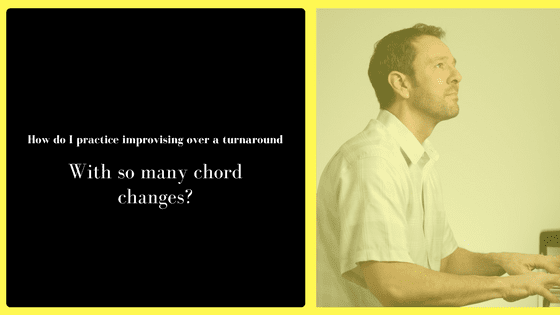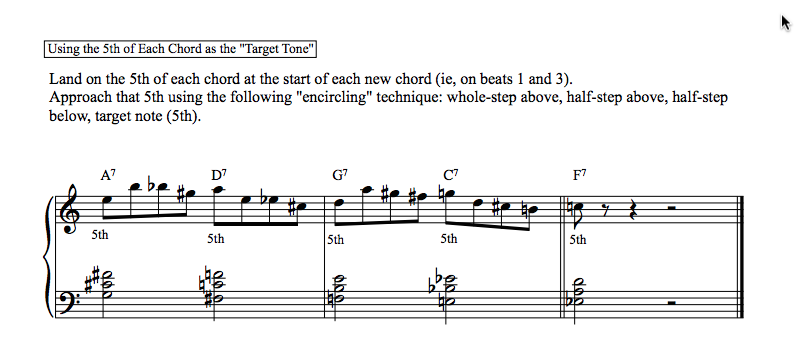How Do I Practice Improvising Over a Turnaround With So Many Chord Changes?

A Premier Student on the site recently asked a great question, and I wanted to share my answer with all of you because I remember struggling with these concepts myself. The question involves how to practice improvising over a two-bar turnaround at the end of a blues form, where the chord changes are coming at you quickly (two beats per chord change).
Here's the question:
My weekend jam buddies and I are playing a 12-bar "F blues" at around 110bpm. I'm really wretched at the 2-bar turnaround! /A7 D7 / G7 C7 /. I put just the turnaround in "Band In A Box" to work on it.
I know part of the problem is I'm probably over-thinking it too much regarding 4 different 2-beat chord scales. I also know I can play an F blues scale over the whole thing (all 4 chords) but that gets dull after a while.
Tonight I started thinking about some of the descending patterns inside of the progression, like C# - C - B - Bb (the 3rd or 7th of each of those chords) and was doing some "enclosure" or approach patterns to each of those notes.
But hey in short what do you suggest on how I can get better at this turnaround or any turnaround in general?
Here is my response to the student:
OK - my suggestions for how to work on the / A7 D7/ G7 C7/ turnaround:
- You already know that the F blues scale will work over all of those chords, and sound good. So make sure that you can really play two different kinds of left hand voicings for those changes while soloing with the F blues scale in your left hand.
The LH voicings I would use would be (1) 4-way close-position voicings and (2) quartal voicings (the A7 chord would be spelled [from bottom up] G-C#-F#, and that shape would be moved down chromatically, so D7 would be spelled F#-C-F, G7 is spelled F-B-E, and C7 spelled E-Bb-D#, resolving finally to F7 spelled Eb-A-D). Having these types of voicings in your LH is important because it helps to make the harmony feel like it's being moved forward, even if you're playing only one scale (ie, blues scale) over the entire progression. - Write out a few (maybe 4) different lines of your own that you can play over this turnaround. Make sure that you can play the "you-know-what" out of these lines that you create. Practice at various tempos, and even 2 or 3 different keys, and be able to execute them flawlessly. Playing with the "Band in a Box" backing loop is excellent practice. At minimum you should be using your metronome and practicing this against a steady beat.
- Transcribe some players playing over such a turnaround. Remember that this is a very common progression that you will hear in many tunes, not only as a turnaround in blues forms but also as the actual changes within many songs, so that means you can listen for this progression in places other than simply blues tunes.
- Understand that this is really a "iii-vi-ii-V" turnaround where each chord is treated as a dominant chord. But you, as the pianist especially, do not have to play the progression as dominant chords every time you encounter it. You can choose to play the dominant chords as described above, or something that looks more like A-7b5 to D7 to G-7 to C7. What that tells me is that it is really just two sets of "ii-V" progressions (ie, A- to D7, and then G- to C7). So if you have any "ii-V" licks, one way to practice this is simply to play the "ii-V" lick in one key (A-7b5 to D7, and you might need to amend the lick slightly as this is a minor "ii-V") and then play that same lick again down a whole step (over the G- to C7 chord). And if you're looking for some great "ii-V" licks to practice, check out our "ii-V Major Licks" AND "ii-V Minor Licks" lessons!
- An advanced approach: Use the chord tones as "target notes" on the downbeat of each new chord change. I've attached one example of how I might practice this technique of soloing (below), which is commonly referred to as "encircling" or "enclosure" or "chromatic approach" but is all really just a discussion on neighbor tones. Basically, in the attached example, the idea is to land on the 5th of each chord on the downbeat of each new chord change. The surrounding 8th-notes fit a pattern that "target" the 5th of the chord: whole-step above the 5th, half-step above the 5th, half-step below the 5th, 5th.
In reality, lots of players play licks over this particular turnaround spot in the blues form because the changes are coming at you very quickly, so my advice would be that it's best to have some material worked out in advance that you can simply whip out when you get to this part of the form. The more practice you get at playing these licks, the more authentic they will eventually start to sound.
Happy Practicing!
